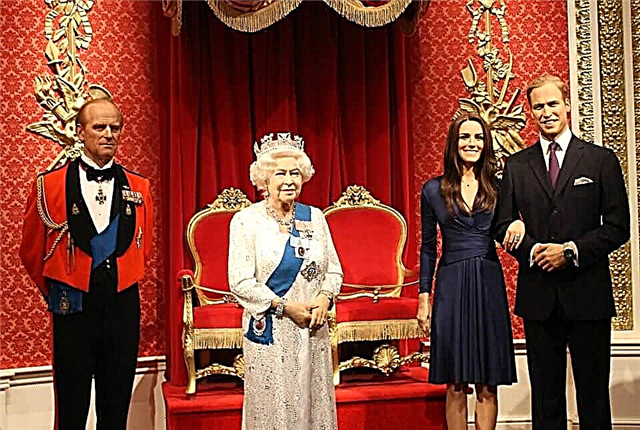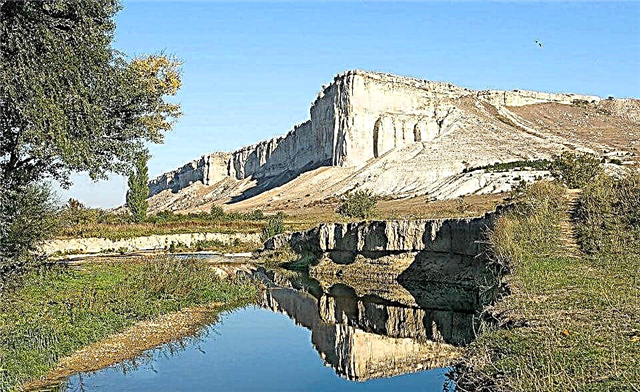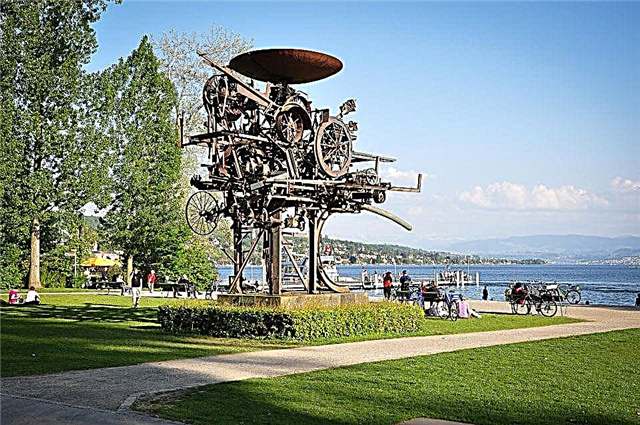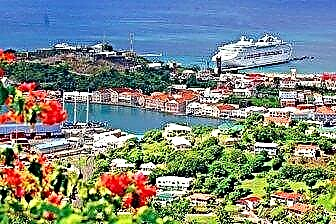Address: Russia, Yaroslavl region, Yaroslavl, st. Rybinskaya, 44g
Start of construction: 1670 year
Completion of construction: 1678 year
Coordinates: 57 ° 37'31.9 "N 39 ° 51'07.6" E
Content:
The small Vladimir temple has unusual shapes - it is crowned with three tents. The old stone church appeared in the city in the second half of the 17th century. It was built on the most remote Yaroslavl churchyard, where the homeless, nameless and vagabonds found their last shelter. Today, there are so few three-hipped churches on the territory of Russia, and each of them can be considered a unique architectural monument.
History of the Vladimir Church on Bozhedomka
In the old days in Russia there were cemeteries where people were buried "random" - nameless wanderers, drowned people and city tramps who left earthly life without repentance. These unfortunates had no relatives, so there was no one to take care of a place for graves and a worthy burial.

In such fenced-off cemeteries or, rather, in mass graves called "squalid houses" or "godless", people were not buried right away, but they dug a large pit and put the bodies one on top of the other. Burial and funeral service according to church traditions took place only once a year - on the seventh day after the celebration of Easter ("seven"), when the procession from the Assumption Cathedral came to the "goddess". Such funerals were carried out at the expense of the city, that is, for Christ's sake. After the hole was filled up, a new one was dug nearby - for burials for the next year.
The Yaroslavl "bozhedomka" was located on the very outskirts of the city, on Vspolye, so named because behind the last houses there were only fields for grazing. Since the beginning of the 17th century, there was a wooden church here, the first mention of which dates back to 1601. The construction of the stone church took place in the period from 1670 to 1678 at the expense of the wealthy Yaroslavl merchant Semyon Astafievich Luzin. This was the time when, on the initiative of the Rostov Metropolitan Iona Sysoevich, stone churches in the diocese began to be built everywhere.
It is surprising that Yaroslavl architects decided to build a temple with hipped roofs. After all, the work began when the decree of the Patriarch-reformer Nikon was already in force in Russia, which prohibited the construction of hipped-roof churches. The canon, which all church parishes had to adhere to, were the cross-domed churches. However, the prohibition of the patriarch was only partially violated, since the overlap of the main volume of the church was nevertheless made cross-domed. And the three hipped roofs played only a decorative role.
The Vladimir Church in Yaroslavl is one of the last tent-roofed temples, which marked the end of an important stage in the ancient Russian architecture of the pre-Petrine period. After her, tent-roofed churches were not built for a long time. And only at the very end of the 19th century, the tradition of tent-roofed temple building began to gradually revive.
In 1691, the walls of the church were painted with frescoes. The wall paintings were then updated twice. In 1819, these works were done by S.A. Ikonnikov, and in 1898 - M.I. Dikarev. The old murals are now whitewashed.
In 1771, by the decree of the Senate for sanitary safety, "gods" were banned everywhere, and they began to bury the homeless outside the city limits. Then, according to the general plan of the governor Alexei Petrovich Melgunov, the city began to change rapidly. Seven years have passed, and during a major urban planning reconstruction, the cemetery around the church was liquidated and moved to the Leontief Church. So the Vladimirskaya church found itself among the city blocks, on the outskirts of Yaroslavl. And today the place where it is located is already considered the historical center of the city.
In 1822, a warm church was built next to the Vladimir Church, dedicated to the feast of the Intercession of the Most Holy Theotokos, revered in Russia. It had features of provincial classicism characteristic of religious buildings - a domed sphere and a multi-tiered bell tower with a baroque finish. At the same time, a neat Vlasyevsky garden was laid out around the Vladimir Church, which all the townspeople immediately fell in love with. On holidays, especially on Trinity, folk festivals were held in the garden. By the beginning of the 20th century, the parish life of the Vladimir Church had grown so much, and several large and small villages were attributed to it.

In 1918, an uprising of the White Guards against Soviet power took place in Yaroslavl. In the difficult days of fighting and destruction for the city, the Red Guard detachment broke into the church and killed the priest who served in it - Father Gennady (Zdorovtsev). In 1929, the church was closed, and its premises began to be used as warehouses.
A year later, the neighboring Church of the Intercession was overhauled. The bell tower and the dome were demolished, and another floor was added over the main volume. As a result, the cult building began to resemble an ordinary residential building. Later, the premises of the former Pokrovsky Church were used for a shop, a workshop of a rubber products plant, various institutions were settled here and warehouses were equipped. And in 2009, after a major renovation, this building was given to the city prosecutor's office.
In 1992, the Vladimir Church was transferred to the management of the Russian Orthodox Autonomous Church.
Architectural features of the Vladimir Church
The main pillarless quadrangle of the temple is small in size and covered with a closed vault. It is adjoined by a lowered rectangular altar apse with three windows. The building stands out noticeably in the surrounding urban development and is clearly visible from Svoboda Street.
As befits a cemetery church for the poor, the exterior decor of the building is modest and laconic. The windows are not framed by platbands - they are simply “recessed” into deep niches along the facades of the building. Of the decorations on the church, there is only a profiled base, a cornice along the walls and small kokoshniks around three blank tents. They, like burning candles, are displayed in a row and crowned with small graceful domes.
A refectory adjoins the temple from the west, and behind it there is a beautiful three-tiered hipped-roof bell tower, in which “rumors” have been made to enhance the acoustics. This bell tower was built in the first half of the 19th century. Such a temple composition, later called a "ship", was only in its infancy at the end of the 17th century.
The current state of the temple and the visiting regime
The temple is active and is under the control of the Suzdal Diocese of the Russian Orthodox Autonomous Church. Divine services are held here regularly. In the church, two thrones are consecrated, dedicated to the Vladimir Icon of the Mother of God and the righteous Lazar the Four-Day, Bishop of China.
How to get to the Vladimir Church on Bozhedomka
The church is located in the Kirovsky district of the city, on the street. Rybinskaya, 44G.
By car. The federal highway M8 leads from Moscow to Yaroslavl. Within the city limits, it is called Moskovsky Prospekt. On it you need to cross the Korotosl River, and from Volkov Square turn left onto Svobody Street. Drive 1.9 km along it and turn left onto st. Lisitsin. The Vladimir temple is located near the intersection of Lisitsin and Rybinskaya streets.
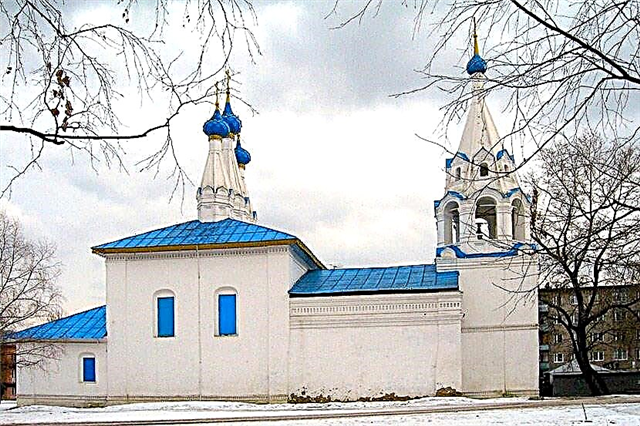
By train. From Moscow to Yaroslavl, express train trains reach in 3 hours 16 minutes. The journey by regular train takes from 4 to 5.5 hours. From Moskovsky railway station in Yaroslavl, the distance to Vladimirskaya church is 5 km. From the bus station "Yaroslavl Glavny" - 1.2 km. You can walk to the temple or take a taxi.


